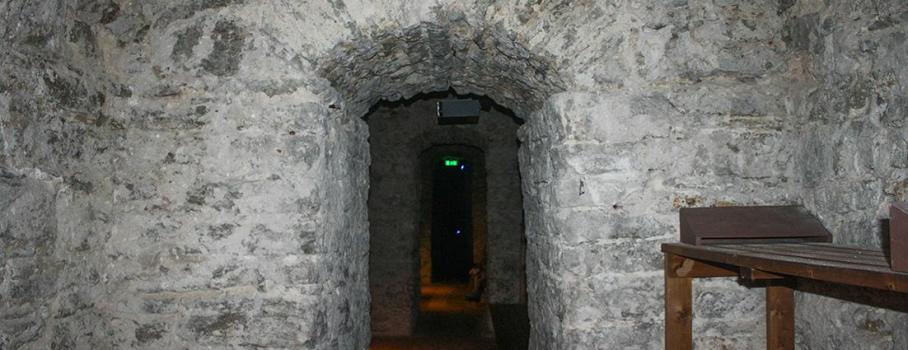Translated into English as “peep into the kitchen,” the artillery tower called Kiek in de Kök received its name as a bit of a nod toward its voyeuristic capabilities—through its small windows, soldiers joked that they could see down the chimneys of the homes below into the kitchens. That, of course, wasn’t its intended purpose—to enable soldiers to be on the lookout for and attack approaching enemies—but the name stuck.
Begun in 1265, the city’s defenses eventually grew over the centuries until they formed a 1.5-mile belt of towers, walls, and gates encircling the Old Town. I had spent several days in Tallinn wandering around, through, and on top of these structures. Now it was time to go into one.
Kiek in de Kök, built in 1475, is one of the 20 of the original 46 defensive towers that still remain. From the base, I admired this formidable structure—a circular 125′-high jumbo-sized tower with walls up to 13′ thick and a red-tile roof topped with one of the countless delightful weather vanes that I kept spotting all over town. At the entrance, I had the choice of going up, to the multiple levels of the museum, or down, into the secret tunnels. I chose to climb first and purchased a ticket for the tunnel tour later.
Obsolete by 1760, the tower was converted into a storage unit and a repository for archives as well as private apartments. In the early 1900s, Estonian athletes used some of the rooms as training quarters. Later in the same century, everything and everyone was cleared out, and the city rehabilitated and repurposed the tower into a public museum.
Up a flight of stairs, I entered a large room with a floor model of the towers outlining the Old Town. Above it, informational videos with performers in period costumes provided a terrific background to the tower and the city itself, reaching way back to when it was called Reval centuries ago yet looked almost exactly like it does today.
I ascended a few more stories, stopping on each one to examine the exhibits on armor, weaponry, and a trio of replica cannons from the 15th century. Tucked into the flayed embrasures that used to house cannons and provide an advantageous location for soldiers to blow away the enemy, old paintings and photographs reveal the development and history of the city, while exhibits ranging from torture devices to the plague reminded me that the good old days weren’t all that good.
The uppermost floor provides a welcome respite from the climbing and history in the form of a convenient café as well as magnificent views of the Old Town and the harbor from the windows around the circumference. Under the curious clock hanging in the middle of the space—a giant stone orb, with a flash of lights circling around it, illuminating the hours of the day along its route—I snacked on a meat pie and downed some orange juice, reenergizing myself for the second part of the tower’s attractions.
Back on the ground level, a quirky orientation film introduced me and the other ticket holders to the Bastion Tunnels, a network of 17th-century underground passageways running under Toompea Hill. Originally built as a defense conveyance and shelter for soldiers, ammunition, and supplies, their purpose shifted in the following centuries in the most unimaginable ways.
As we descended below ground and entered the tunnels, the drop in temperature was shocking. I could only imagine what it was like for the prisoners of war who were held here during military engagements. Narrow stone passageways and arches led from chamber to chamber, occasionally branching off to the sides down unlit corridors. I could tell how sturdily these tunnels had been constructed—ideal for their unintended use as air-raid shelters during World War I and bomb shelters during World War II. During the Cold War, electricity, ventilation, water, and phone systems were installed, preparing the space in the event of a nuclear strike for, well, not everybody—just the rich.

Far below ground, the Bastion Tunnels have served as everything from a bomb shelter to a punk rocker hangout.
After that threat faded, the National Art Foundation stored its sculptures in the tunnels, but that lasted only a couple of years when it began to fear that thieves would find a way in and make off with its treasures. Now totally abandoned, the tunnels became a safe haven for punk rockers to congregate in the 1970s when the restrictive Soviets tried to squelch that particular genre of music. They were soon pushed out by both displaced people who started to use the tunnels as their home and criminals hiding from the police, who weren’t keen on chasing them into and through the tunnels that were infested with rats and fleas.
It wasn’t until 2005 that both humans and vermin were forced out so that the tunnels could be converted into a public museum. The tunnels contain few exhibits, such as a mannequin donning a gas mask or some graffiti about the Sex Pistols. The real attraction is the tunnels themselves, where your imagination struggles to comprehend everything that has transpired here and conjures up the most horrifying visions when the guide temporarily turns off all the lights, plunging you into total darkness and giving you an inkling of what nyctalopia might be like. Given its tortuous history, I wondered if the tunnels had reached their final installment as a museum, or if another chapter awaits.



